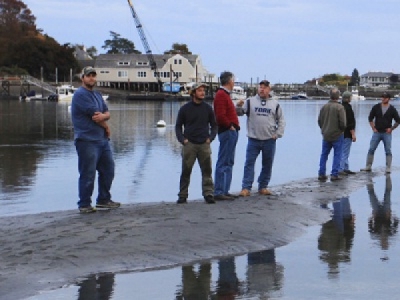
Posted on October 18, 2016
By Kate McCormick and J. Craig Anderson, Portland Press Herald
York town officials are fighting for federal funding to remove a buildup of sediment in York Harbor that threatens to ground local fishermen and recreational boaters alike.
As part of their effort to draw attention to the problem, the Town of York Harbor Board staged a demonstration Sunday to show how silt deposits from the York River encroach on mooring areas, forming shoals that crest the water at low tide. A group of fishermen and harbor officials stood atop a mound of sediment that juts above the water level at low tide in the middle of one of the harbor’s basins, near the mouth of the river.
“The silt that comes down the river … it sweeps in there and it just dumps,” said Harbor Board member and fisherman Dave Gittens. “People run aground there all the time – especially people who are not familiar with it.”
The silt deposit already has displaced two of the 20 commercial fishing boats usually moored in the harbor, and others must be careful not to run aground when navigating to or from their slips, said York Harbormaster David Hutchinson. “They can’t come in at low tide,” he said.
According to Harbor Board Chairman David Webber, York Harbor contains moorings for about 330 commercial and recreational boats. Another 200 boats use the harbor regularly but are moored in private marinas. The harbor generates $12 million to $15 million of economic activity each year, he said.
“We don’t want to lose any of it, especially with fishing being such a tough business right now,” Webber said.
The town spent more than four years performing environmental studies, securing permits and raising matching funds for an estimated $2.5 million dredging project but learned earlier this year that the town had been passed over for federal dollars.
Federal funding for small harbor projects is extremely limited, with about $50 million allotted for small harbors across the country. Many times, harbors like York’s will lose out to larger ports with more commercial traffic, said Jack Karalius, the Army Corps of Engineers project manager overseeing York’s application process.
“We’re all set with the permits and approvals,” Karalius said. “We’ve been putting in for York for the past couple of years, but York has to compete against all the other harbors across the country.”
York officials said they worry that competition for federal funding will only increase as more harbors complete their own testing and permitting processes.
In Maine alone, there are three harbors with the required permits that are awaiting federal funds to move forward with dredging projects, Webber said. Three others are in the process of obtaining permits and are expected to join the waiting list soon, he said.
Each municipality’s dredging permit has a five-year shelf life. If a city or town does not receive funding within that time frame, it must start the process over again.
Maine’s U.S. Sen. Susan Collins, who sits on the Senate committee on appropriations which oversees the Army Corps of Engineers’ budget, said she and Senate colleague Angus King have pushed to get more harbor project funding to Maine.
“Ports and harbors, like those in York and Saco, are an integral part of Maine’s coastal communities,” Collins and King said in a joint statement. “We will continue to ask the Army Corps to address Maine’s needs, and we also will work to secure a stronger investment that can help fund projects at small ports and harbors that require important maintenance.”
The Saco River is also in “dire need of dredging,” Collins and King said.
York’s lobstermen say the sediment buildup is already affecting their hauls. There is no commercial fishing in York Harbor itself, but in order to move in and out smoothly, lobster boats need anywhere from three to five feet of water. In several areas of York Harbor, the water is less than 18 inches deep at low tide. That leaves York’s lobstermen in a bind, said Mike Sinclair, a lobsterman and member of the York Harbor Board.
“It can limit their business because you have to come in early or leave later,” Sinclair said. “You have a short time to make your money in lobstering, and when you have to pick and choose your times it affects your bottom line.”
Sinclair estimated that 70 percent of York’s fishermen have been affected by the shrinking harbor space. The harbor was last dredged in 1996, and before that in 1975 and 1950, Webber said.
“So it’s been exactly 20 years,” he said. “It’s way overdue.”
York residents will have to wait until early next year when the federal budget is released to learn if their harbor has been selected for dredging.
According to the Maine Lobstermen’s Association, lobstermen up and down the Maine coast are grappling with similarly diminishing harbors,
“Dredging is … fundamental to keeping our waterfronts working,” said Patrice McCarron, executive director of the association.
Maine’s lobster industry has seen record landings and sales both at home and abroad. In the first half of 2016, Maine’s lobstermen pulled in $103 million in foreign sales, more than twice the previous year, because of high demand in Asia.
But Sinclair said lobstermen like him cannot take advantage of the hot market if they can’t get their boats in and out of their home ports. With only a couple of months left in the season, Sinclair said he cannot overstate the importance of fixing York Harbor’s sediment problem.
“We need it done,” Sinclair said. “We need it done yesterday.”
Source: Portland Press Herald





